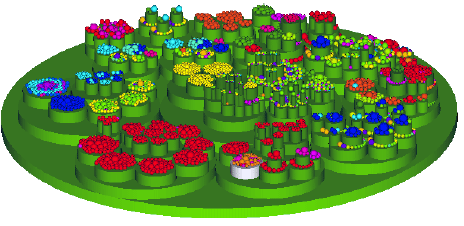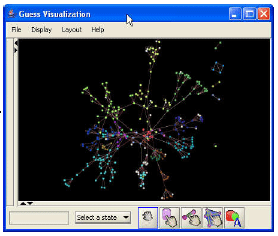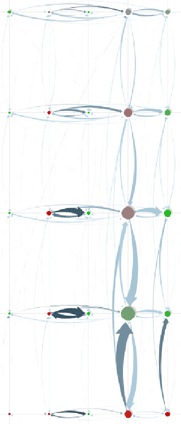| a. Visualization of Large Hierarchical Data by Circle Packing (paper) Yet another Treemap in circular form. The paper describes algorithm that they apply to make a pleasant distributed circle within the circular Treemap. Lynda and I talked about the square Treemap view at our last meeting (link) Critique: This form of interface is not novel and has been implemented in Grokker, although the author claims to be different from Grokker because it chooses to display all the child node within the hierarchy (Grokker only display detail of child items only on mouse click event and hide details otherwise). Essentially it is an interaction decision in which Grokker has made the right one. |
 |
| b. GUESS: A Language and Interface for Graph Exploration (paper) This paper concentrates on finding solutions on how a complex graph creation can be very easy via simple language, so non programmers can use it too. The language tool itself is an extension of Python. The author is also the maker of Profuse. A java-based open source visualization tool. Available at http://graphexploration.cond.org/ This interface is interesting because it can be a plug-in for any kind of visualization just by using a simple language. Might come in handy in the future.
|
 |
| c. Visual Exploration of Multivariate Graph (paper) Also called the PivotGraph. It is an interesting new set of graph where the property of a node (instance) is visualized rather then the instance itself. As a result, what can be seen is relationships between different values of a property. Two new things that the Pivoted graph offer: a. solution to the spaghetti problem (a tangled-illegible-complicated graph of many nodes) by compressing the nodes and presenting only the values of the properties.b. a new insight to the data itself specially on comparisons. un-tackled problem: 1. will not work well if there are too many values of a property (4 or more), it will in turn look like a spaghetti itself.2. does not differentiate/represent multiple relationships of the same node. For eculture this kind of visualization is interesting specially when we want to provide answers to use case such as: - "do artists from one county typically knows artists from another country?", "how many dutch artists are affiliated with italian artists?"- "are there any trends of art materials used by certain artist from certain artstyles?" |
 |
| d. Visualizing Email Content: Portraying Relationships from Conversational
Histories (paper) Datasets: Email of a person throughout time. Method: Analyzing most frequent unique words used in the body of the emails for visualization. What the interface shows: relationships of a person with other people throughout time. Critique: good (to be precise: fun) for global view and relationship analysis but not helpful for directed search.
|
 |